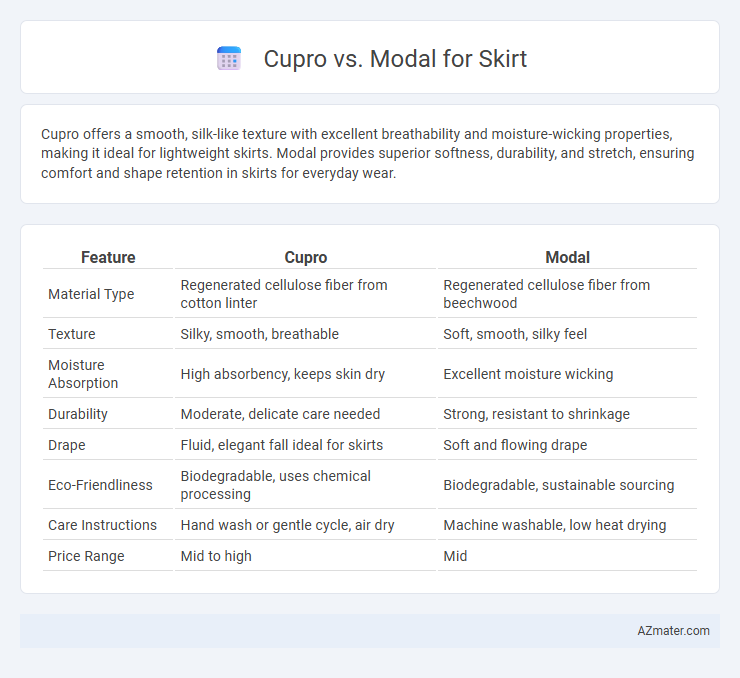Cupro offers a smooth, silk-like texture with excellent breathability and moisture-wicking properties, making it ideal for lightweight skirts. Modal provides superior softness, durability, and stretch, ensuring comfort and shape retention in skirts for everyday wear.
Table of Comparison
| Feature | Cupro | Modal |
|---|---|---|
| Material Type | Regenerated cellulose fiber from cotton linter | Regenerated cellulose fiber from beechwood |
| Texture | Silky, smooth, breathable | Soft, smooth, silky feel |
| Moisture Absorption | High absorbency, keeps skin dry | Excellent moisture wicking |
| Durability | Moderate, delicate care needed | Strong, resistant to shrinkage |
| Drape | Fluid, elegant fall ideal for skirts | Soft and flowing drape |
| Eco-Friendliness | Biodegradable, uses chemical processing | Biodegradable, sustainable sourcing |
| Care Instructions | Hand wash or gentle cycle, air dry | Machine washable, low heat drying |
| Price Range | Mid to high | Mid |
Introduction: Cupro vs Modal Skirts
Cupro skirts offer a luxurious, silk-like texture with excellent breathability and moisture-wicking properties, making them ideal for warm weather. Modal skirts, derived from beech tree pulp, provide exceptional softness, durability, and resistance to shrinkage, perfect for everyday wear. Both fabrics are sustainable choices, but Cupro's natural sheen contrasts with Modal's matte finish, influencing the skirt's overall aesthetic and drape.
What is Cupro?
Cupro is a sustainable fabric made from regenerated cellulose fibers derived from cotton linter, offering a silky texture and excellent breathability ideal for skirts. Its natural origin allows it to be biodegradable and hypoallergenic, making it a popular eco-friendly alternative in fashion. Compared to Modal, Cupro provides a smoother finish and better drape, enhancing the flow and comfort of skirts.
What is Modal?
Modal is a type of semi-synthetic cellulose fiber made from beech tree pulp, known for its softness, breathability, and excellent moisture-wicking properties, making it ideal for comfortable skirts. Cupro, derived from cotton linter, offers a silky texture and smooth drape but is less breathable compared to Modal. Choosing Modal for skirts enhances wearability in warm climates due to its superior airflow and durability compared to Cupro.
Key Differences Between Cupro and Modal
Cupro, a regenerated cellulose fiber derived from cotton linter, offers a silk-like sheen and superior breathability, making it ideal for skirts requiring a luxurious drape and moisture-wicking properties. Modal, produced from beech tree pulp, provides exceptional softness, greater elasticity, and enhanced resistance to shrinkage, suitable for skirts needing durability and comfort. The key differences lie in Cupro's smooth, glossy finish versus Modal's matte softness, with Cupro excelling in fluidity and Modal delivering higher stretch and resilience.
Comfort & Feel: Cupro vs Modal
Cupro offers a silky, breathable texture with excellent moisture absorption, making skirts feel cool and smooth against the skin. Modal provides a soft, stretchy fabric that drapes well and maintains comfort even during extended wear due to its high elasticity. Both fibers excel in comfort, but Cupro stands out for its luxurious sheen and natural breathability, while Modal is favored for its softness and durability.
Durability & Longevity
Cupro fabric offers superior durability for skirts due to its strong, regenerated cellulose fibers, resisting wear and maintaining shape over time. Modal, while soft and breathable, tends to lose strength after multiple washes, affecting skirt longevity. Choosing Cupro ensures a longer-lasting skirt with sustained aesthetic appeal.
Sustainability and Eco-Friendliness
Cupro is a sustainable fabric derived from regenerated cotton linter, offering biodegradability and minimal environmental impact during production. Modal, made from beech tree pulp, excels in eco-friendliness due to its renewable sourcing and lower water consumption compared to conventional cotton. Both fabrics provide biodegradable alternatives to synthetic materials, but Cupro's use of cotton byproducts highlights effective resource utilization in sustainable skirt manufacturing.
Care and Maintenance Tips
Cupro skirts require gentle washing in cold water and air drying to maintain their silky texture and prevent shrinking, while Modal skirts benefit from machine washing on a delicate cycle with mild detergent to preserve their softness and color vibrancy. Avoid using bleach or fabric softeners on both fabrics to extend their lifespan and always iron Cupro on low heat, whereas Modal can withstand medium heat settings safely. Proper storage in a cool, dry place helps prevent fabric damage and maintains the shape of Cupro and Modal skirts.
Best Uses for Cupro Skirts vs Modal Skirts
Cupro skirts excel in offering a luxurious, silky texture with excellent breathability, making them ideal for warm-weather occasions and formalwear due to their smooth drape and high moisture-wicking properties. Modal skirts stand out for superior softness, durability, and stretch, making them perfect for everyday casual wear and active lifestyles where comfort and easy care are priorities. Choosing between cupro and modal skirts depends on whether the priority is a polished, elegant look with natural breathability or a versatile, soft fabric suited for frequent wear and movement.
Which Fabric Should You Choose for Your Skirt?
Cupro offers a silky, breathable texture with excellent drape, making it ideal for elegant, flowy skirts that feel luxurious against the skin. Modal, derived from beech trees, features superior moisture-wicking and softness, providing durability and comfort suitable for everyday skirts with a casual yet polished look. Choose Cupro for a sophisticated finish in warm weather, while Modal excels in versatility and easy care for all-day wear.

Infographic: Cupro vs Modal for Skirt
 azmater.com
azmater.com